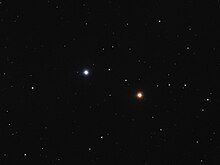Image de
ν1 (étoile orangée à droite) et de ν
2 Bootis (étoile bleue-blanche à gauche)
Orbite
Demi-grand axe (a )
0,061 5 ± 0,000 7 ″
Excentricité (e )
0,006 ± 0,015
Période (P )
9,026 ± 0,017 ans
Inclinaison (i )
109,7 ± 1,2°
Argument du périastre (ω )
293 ± 9°
Longitude du nœud ascendant (Ω )
199,4 ± 0,9°
Époque du périastre (τ )
2 000,75 ± 0,24 JJ
Désignations
modifier
Nu2 Bootis (ν2 Bootis / ν2 Boo) est une étoile binaire [ 10] constellation boréale du Bouvier . Elle est visible à l’œil nu comme une faible étoile blanchâtre de magnitude apparente 5,02[ 2] a.l. pc vitesse radiale héliocentrique de −17 km/s [ 5]
La paire d'étoiles possède une orbite quasiment circulaire, qu'elle complète en une période de neuf ans et avec un demi-grand axe de 0,0615 seconde d'arc [ 10] spectre similaire. L'étoile primaire, désignée ν2 Bootis A, est une étoile blanche de la séquence principale de type spectral A5 V [ 4] étoile à enveloppe (shell star disque circumstellaire de gaz orbitant soit l'une soit les deux étoiles[ 11] lumineux que le Soleil et il présente une température effective de 8 472 K [ 7]
↑ a b c d e et f
(en) A. G. A. Brown et al. Gaia collaboration), « Gaia Data Release 2 : Summary of the contents and survey propertiesAstronomy & Astrophysics vol. 616, août 2018 , article no A1 (DOI 10.1051/0004-6361/201833051 Bibcode 2018A&A...616A...1G arXiv 1804.09365 Notice Gaia DR2 pour cette source sur VizieR .
↑ a b c et d (en) H. L. Johnson et al. UBVRIJKL photometry of the bright stars », Communications of the Lunar and Planetary Laboratory vol. 4, no 99, 1966 (Bibcode 1966CoLPL...4...99J ↑ (en) B. D. Mason et al. The Washington Visual Double Star Catalog », The Astronomical Journal vol. 122, 2014 , p. 3466–3471 (DOI 10.1086/323920 Bibcode 2001AJ....122.3466M ↑ a et b (en) A. Cowley et al. A study of the bright A stars. I. A catalogue of spectral classifications », The Astronomical Journal vol. 74, avril 1969 , p. 375–406 (DOI 10.1086/110819 Bibcode 1969AJ.....74..375C ↑ a et b (en) J. H. J. de Bruijne et A.-C. Eilers , « Radial velocities for the HIPPARCOS-Gaia Hundred-Thousand-Proper-Motion project », Astronomy & Astrophysics vol. 546, octobre 2012 , p. 14, article no A61 (DOI 10.1051/0004-6361/201219219 Bibcode 2012A&A...546A..61D arXiv 1208.3048 ↑ (en) E. Anderson et Ch. Francis , « XHIP: An extended Hipparcos compilation », Astronomy Letters vol. 38, no 5, mai 2012 , p. 331 (DOI 10.1134/S1063773712050015 Bibcode 2012AstL...38..331A arXiv 1108.4971 ↑ a b c d et e (en) J. Zorec et F. Royer , « Rotational velocities of A-type stars. IV. Evolution of rotational velocities », Astronomy & Astrophysics vol. 537, janvier 2012 , A120 (DOI 10.1051/0004-6361/201117691 Bibcode 2012A&A...537A.120Z arXiv 1201.2052 ↑ (en) W. I. Hartkopf , B. D. Mason et C. E. Worley , « Sixth Catalog of Orbits of Visual Binary Stars (consulté le 13 septembre 2017 ) ↑ (en) * nu.02 Boo -- Double or multiple star sur la base de données Simbad Centre de données astronomiques de Strasbourg .↑ a et b (en) P. P. Eggleton et A. A. Tokovinin , « A catalogue of multiplicity among bright stellar systems », Monthly Notices of the Royal Astronomical Society vol. 389, no 2, septembre 2008 , p. 869–879 (DOI 10.1111/j.1365-2966.2008.13596.x Bibcode 2008MNRAS.389..869E arXiv 0806.2878 ↑ (en) B. Hauck et C. Jaschek , « A-shell stars in the Geneva system », Astronomy & Astrophysics vol. 354, février 2000 , p. 157–162 (Bibcode 2000A&A...354..157H
Liens externes

